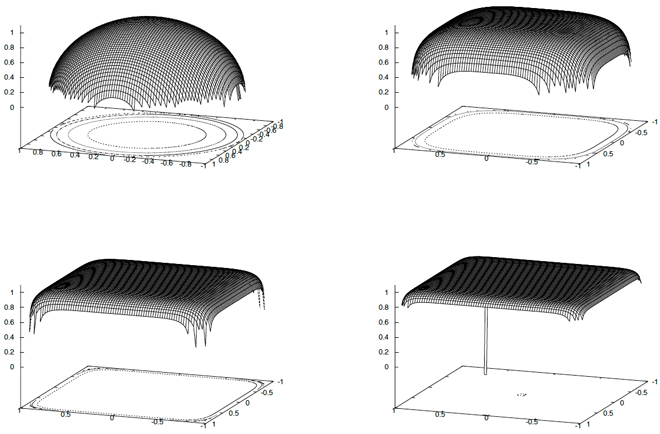And then - what is "to be "?

A wave function that interpolates between a sphere (for N = 2) and a cube (as N → ∞) for N = 2, 4, 8, 12
Neutron stars can give neutrons a cubic shape
Wired, Aug 16, 2011Gravity and high density inside exploding stars can cause neutrons to change from spherical to cubic.
This idea could mean that neutron stars (as researchers call stellar "corpses") are denser than anyone thought. The question may also arise - what can prevent them from turning into black holes and disappearing completely?
"If we take this result at face value, it means that neutron star theorists are in trouble." [Neutron stars] should turn into black holes at lower masses, "said theoretical physicist Felipe José Lanes-Estrada of the Complutense University of Madrid, co-author of the study, published Aug. 9on the arXiv preprint site.
“But we are not seeing this. There may be additional interactions [between neutrons] that can resist decay. An interaction we haven't even thought about yet, ”he said.
A star with a mass 9-20 times that of the Sun will explode as a supernova by the end of its life. With this weight, the star is not heavy enough to gain critical superdensity and collapse into a black hole. Instead, its core shrinks into a sphere no more than 15 miles in diameter. This sphere is so dense that one teaspoon of the substance of which it is composed weighs as much as 18 Earth planets.
Late last year, astronomers discovered the world's largest neutron star, called J1614-22307 The mass of this star was equal to the mass of the Sun times 1.97. The most massive neutron star before this discovery had a mass equal to 1.67 solar masses.
This discovery has caused a number of astrophysicists to think seriously. The existence of such a star ruled out some models of neutron stars that relied on exotic forms of matter, and now these models cannot explain the delay in the decay of such a heavy object. On the contrary, this discovery confirmed the correctness of models of neutron stars containing only neutrons and protons.
When Lanes-Estrada and his university colleague Gaspar Moreno Navarro heard about J1614-2230 , they wanted to know more about the processes inside this star.
The two knew about the 1970s model, which suggested that pure neutrons could form a crystal lattice under incredible pressure (much like carbon forms diamonds in the interior of the Earth). When they built a computer model for this idea, they found that under the pressure that develops deep in the neutron stars, neutrons are deformed from spheres into cubes.
“The optimum density at which spheres are formed (including neutrons) is about 74%. Regardless of the location, there is always space between them - like with oranges in a supermarket showcase, ”said Lanes-Estrada. “If you want to arrange oranges as efficiently as possible, some of them will wrinkle. Lay them out on a one and a half meters high display case, and the lower ones will be crushed. "
Gravity transforms particles of matter into the simplest, most rationally packed object. Typically, such an object is a sphere similar to the Earth. The particles themselves, however, are not individually affected; gravity is too weak to overcome the strong bonds that hold neutrons and other particles together. But if the force of gravity is strong enough, it can overcome these connections.
Thus, in the depths of the newly discovered neutron star, the core pressure of which can be twice as high as that of the rest, the most effective form of a neutron can be a cube. “They will be flattened on all sides like bones, with the pressure readings starting at the values seen 2.5 miles underground,” said Lanes-Estrada.
So far, the study has been met with positive reviews.
Particle physics expert Richard Hill of the University of Chicago, for example, noted that research treats the neutron as an object in isolation, not as an aggregate.
"This is an interesting idea, but it is not yet clear what is going on in the aggregate of neutrons," said Hill, who was not involved in the study. Based on the density in neutron stars, he noted that "the identity of individual neutrons can be blurred."
Lanes-Estrada acknowledged the criticism formulated by a second physicist who wished to remain anonymous. Lanes-Estrada replied that he also pursued the goal of pushing the boundaries of research.
"I think there is a great deal of uncertainty about what happens to neutrons at very high pressures," he said. must continue to explore all possibilities. "

Learn more about how to get a high-profile profession from scratch or Level Up in skills and salary by taking SkillFactory's paid online courses:
- Training the Data Science profession from scratch (12 months)
- Analyst profession with any starting level (9 months)
- Machine Learning Course (12 weeks)
- Python for Web Development Course (9 months)
- DevOps course (12 months)
- Profession Web developer (8 months)
Read more
- Trends in Data Science 2020
- Data Science is dead. Long live Business Science
- Cool Data Scientists don't waste time on statistics
- How to Become a Data Scientist Without Online Courses
- 450 free courses from the Ivy League
- Data Science for the humanities: what is "data"
- Data Sciene : Decision Intelligence